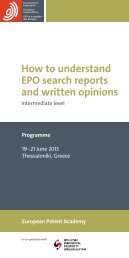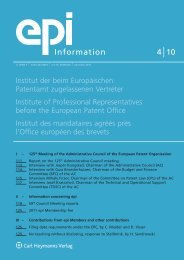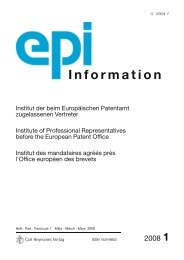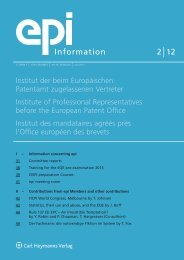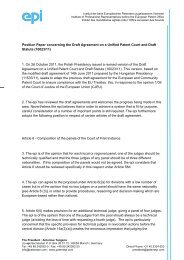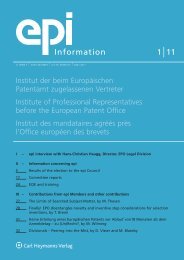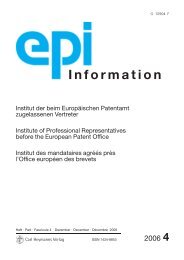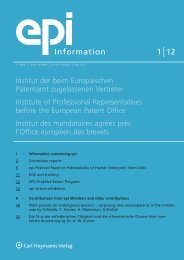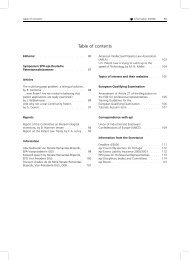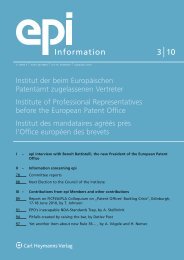epi Information 2/2009
epi Information 2/2009
epi Information 2/2009
Create successful ePaper yourself
Turn your PDF publications into a flip-book with our unique Google optimized e-Paper software.
<strong>Information</strong> 2/<strong>2009</strong> Articles 61<br />
3.1 Effects on EPO staff and European Patent Attorneys<br />
One effect of the backlog in examination is that, often,<br />
12 months elapse between an examiner issuing a communication<br />
and the examiner being able to read the<br />
representative’s response. So the examiner has to invest<br />
significant time in re-familiarising himself with the case.<br />
A far less well understood issue is that the backlog in<br />
examination leads to many European Patent Applications<br />
not remaining with the same patent examiner for<br />
the whole time period up until grant. It is even more likely<br />
that there will be a change of representative between an<br />
invention being submitted by an inventor for drafting as<br />
a patent application, and the eventual grant of a European<br />
Patent.<br />
The main reasons for changes in responsibility<br />
between examiners or representatives over a timescale<br />
of 3-7 years are: staff resigning; staff retiring; staff<br />
moving to a new role, such as the EPO Board of Appeal<br />
or litigation in a patent firm; extended illness; maternity<br />
leave; setting up work dockets for newly recruited staff;<br />
peaks and troughs of workload requiring the hand-over<br />
of work between colleagues.<br />
Each time that responsibility for a patent application<br />
passes from one patent examiner to another:<br />
(i)<br />
There is a need for the new examiner to read the<br />
application, and to familiarise himself with everything<br />
that has happened in the case so far.<br />
(ii) There is a significant risk that the new examiner will<br />
only partially understand the relevance of the prior<br />
art, which is often extensive and may have to be read<br />
and decided upon all in one go.<br />
Point (i) is an enormous drain on the time of highly<br />
qualified staff. Point (ii) leads to decisions of poorer<br />
quality than would otherwise be the case.<br />
Points (i) and (ii) also apply to European Patent Attorneys<br />
who take over cases. The duty of care on representatives<br />
in private practice requires them to take great<br />
care when taking over responsibility for a patent application,<br />
either within their own firm or from another firm.<br />
As a result, much time is wasted, each time that an<br />
application passes from one representative to another.<br />
That time usually cannot be charged to clients.<br />
A representative who takes over a patent application<br />
also needs to try and understand the commercial motivation<br />
for prosecuting a patent application. The representative<br />
who drafted the application may have spent<br />
several hours with the inventor, and may have worked<br />
for several years with the company that provided the<br />
invention. Such knowledge of an applicant’s needs is not<br />
available to a new representative. So the new representative<br />
may typically have to spend a great deal of time<br />
understanding which claims to pursue, in order to<br />
achieve the grant of claims that are of greatest value<br />
to the applicant. The risk is always that claims may be<br />
pursued when an application really should be dropped,<br />
or even that an application is dropped that still has value.<br />
Often, the most significant issue for European Patent<br />
Attorneys is the need to contact the applicant or inventor,<br />
prior to drafting a response to an EPO communication.<br />
The issues in the preceding paragraph are made<br />
much worse by the fact that, in large industrial companies,<br />
inventors have usually either left a company or<br />
moved to a new part of a company, 3-7 years after the<br />
filing of a patent application. So a frequent task for a<br />
representative is to try and find another employee who<br />
knows whether or not an application is still important.<br />
Persuading someone in industry to put time into someone<br />
else’s patent application, for which filing awards<br />
have often already been paid, is a skill in itself.<br />
In addition to these practical difficulties, the negative<br />
effects on motivation of taking over large backlogs of<br />
partially examined cases are very great, both for EPO<br />
examiners and European Patent Attorneys. Most people<br />
in the patent system have experienced the sinking feeling<br />
of knowing that a colleague is leaving, and that that<br />
colleague’s workload now needs to be divided up<br />
amongst those people who are left.<br />
3.2 Assessing an invention years later<br />
A major problem arises from the total amount of time<br />
between an application being filed and a final decision<br />
whether or not an invention was ’non-obvious’ at the<br />
time of filing.<br />
The biggest issue for quality, many years after an<br />
application was filed, is that it becomes increasingly<br />
difficult for examiners or representatives to provide<br />
convincing arguments whether or not a claim was ’nonobvious’<br />
many years ago. Many people have sat in an<br />
oral proceedings at the EPO and have had to imagine<br />
what was known and ’common general knowledge’<br />
many years previously.<br />
3.3 What effects do backlogs have on the other parties<br />
involved?<br />
Returning to the figure of 485700 European Examination<br />
files awaiting examination, it is clear that these<br />
cases create great uncertainty for third parties.<br />
Any company wishing either to commence production<br />
or a service in Europe will be faced with hundreds, or<br />
possibly thousands, of pending patent applications. Any<br />
single one may affect the viability of that company’s<br />
planned project. So large backlogs provide a hugely<br />
uncertain commercial environment. Uncertainty is the<br />
enemy of business planning. Inevitably, this uncertainty<br />
raises risk, and hence the cost of entering markets, which<br />
is exactly the opposite of what is needed. Ironically,<br />
patent proprietors also suffer from this uncertainty, since<br />
they have little hope of valuing the licensing potential of<br />
a European Patent Application at most stages up until<br />
grant.<br />
3.4 Do backlogs bring any benefits?<br />
Backlogs represent a form of deferred examination by<br />
default. However, the amount of deferral for an individual<br />
application is unknown, since it depends on the<br />
backlog in the particular technical field. So this is effectively<br />
deferred examination by lottery.<br />
In addition, there is no mechanism for a third party to<br />
request examination of a patent application that is of<br />
concern to a business’ planned activities. A party submitting<br />
observations under Art. 115 EPC does not



